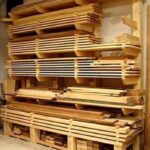Woodworking mallets are essential tools in any woodworking project, providing the necessary force to drive chisels, carving tools, and dowels without damaging them. The choice of wood for crafting these mallets plays a crucial role in their effectiveness and durability. In this article, we will delve into the world of woodworking mallet wood, exploring the different types of wood commonly used for making mallets and how to choose the right one for your specific needs.
When it comes to woodworking mallets, selecting the appropriate wood is key to ensuring a successful outcome. Different woods offer varying levels of hardness, weight, and durability, which directly impact the performance of the mallet. By understanding the characteristics of each type of wood and how it can affect your woodworking projects, you can make an informed decision on which wood to use for your mallet.
Furthermore, crafting a woodworking mallet from scratch requires certain tools and techniques to achieve a functional and visually appealing result. From sawing the wood to shaping and assembling the pieces together, each step contributes to the overall quality of the finished product.
In the following sections, we will explore the different types of woods ideal for woodworking mallets, provide tips on selecting the best option for your needs, and guide you through a step-by-step process on how to create your own woodworking mallet using quality wood.
Types of Wood for Woodworking Mallets
Woodworking mallets are essential tools for woodworkers, used for a variety of tasks such as chiseling, carving, and assembling wood pieces. When it comes to crafting woodworking mallets, choosing the right type of wood is crucial to ensure durability, functionality, and aesthetics. In this section, we will dive into the most common types of wood used for making mallets and their characteristics.
Hardwoods
Hardwoods such as maple, oak, cherry, and walnut are popular choices for crafting woodworking mallets due to their durability and resilience. Maple is known for its strength and shock-absorbing properties, making it ideal for heavy-duty woodworking tasks. Oak is another hardwood commonly used for mallets thanks to its toughness and resistance to wear and tear. Cherry and walnut are valued for their attractive grain patterns and overall aesthetic appeal in woodworking projects.
Exotic Woods
Exotic woods like padauk, wenge, and ebony add a unique touch to woodworking mallets with their distinctive colors and grain patterns. Padauk’s bright red-orange hue adds a pop of color to mallet designs, while wenge’s dark brown tones create a sophisticated look. Ebony is prized for its deep black color and fine texture, making it a luxurious choice for high-end woodworking tools.
Softwoods
Though less common than hardwoods or exotic woods, softwoods like pine and cedar can also be used for crafting woodworking mallets. While softwoods may not offer the same level of durability as hardwoods, they can still be suitable for lighter woodworking tasks or decorative purposes. Pine is lightweight and easy to work with, while cedar’s natural oils provide insect resistance – ideal for outdoor woodworking projects.
Understanding the characteristics of different types of wood will help you make an informed decision when selecting the best wood for your woodworking mallet based on your projects’ requirements. Whether you prioritize strength, aesthetic appeal, or ease of use, there is a wide range of options available to suit your needs when it comes to crafting your own woodworking mallet from quality woodworking mallet wood.
Choosing the Right Wood
When it comes to selecting the right wood for your woodworking mallet, understanding the characteristics of different types of wood is key. The choice of wood will impact the weight, durability, and overall performance of your mallet. Some common types of wood used for crafting woodworking mallets include oak, maple, hickory, and ash.
Oak is known for its strength and durability, making it a popular choice for mallet heads. Maple offers a good balance between hardness and shock resistance, while hickory is valued for its flexibility and shock absorption. Ash is another popular choice due to its density and resilience.
Considerations When Choosing Wood for Your Woodworking Mallet
Before selecting the wood for your woodworking mallet, consider factors such as the type of projects you typically work on, your personal preferences in terms of weight and balance, as well as the tools you frequently use. For heavy-duty pounding tasks, a denser wood like hickory may be more appropriate.
If you prefer a lighter-weight mallet for delicate chiseling or carving work, maple or ash could be a better option. Additionally, think about the aesthetics you want to achieve – some woods have unique grain patterns that can enhance the visual appeal of your mallet.
Tips for Selecting Quality Wood
When choosing wood for your woodworking mallet project, look for pieces that are free from knots, cracks, or other imperfections that could weaken the structure. Opt for straight-grained wood when possible to ensure strength and stability in your mallet.
Additionally, consider how the chosen wood will interact with finishes or treatments if you plan on adding any protective coatings or stains to your mallet. By taking these factors into account and being mindful of your specific project requirements, you can select the best wood for crafting a high-quality woodworking mallet tailored to your needs.
Tools Required for Crafting a Woodworking Mallet
Crafting a woodworking mallet from wood is a fulfilling and practical project for any woodworker. To successfully create your own woodworking mallet, you will need the right tools to ensure precision and efficiency in the process. Here is a list of essential tools required for crafting a woodworking mallet:
Tools:
1. Wood Selection: Choose a dense and sturdy type of wood for your woodworking mallet, such as hickory, maple, or oak. These woods are durable and provide excellent shock absorption, making them ideal choices for mallets.
2. Saw: A saw (such as a handsaw or table saw) will be needed to cut the selected wood into the appropriate sizes and shapes for your woodworking mallet.
3. Chisels: Chisels are essential for shaping the wood and creating the striking face of your woodworking mallet. Make sure to have various sizes of chisels for different tasks.
4. Mallet Head Template: Having a template of the desired shape and size of your woodworking mallet head will help guide you in shaping the wood accurately.
5. Sandpaper: Sandpaper in varying grits is necessary to smooth out rough edges, shape curves, and achieve the desired finish on your woodworking mallet.
6. Clamps: Clamps are essential for securing pieces of wood together during gluing or shaping processes to ensure stability and precision in construction.
Using these essential tools, you can craft a high-quality woodworking mallet that suits your specific needs and preferences. Remember to prioritize safety while using these tools by wearing appropriate protective gear such as goggles and gloves during the crafting process. Enjoy the satisfaction of creating a useful tool from scratch with quality woodworking mallet wood.
Step-by-Step Guide to Making a Woodworking Mallet
A woodworking mallet is an essential tool for any woodworking enthusiast, used for driving chisels, striking gouges, and assembling joinery with precision. Making your own woodworking mallet from wood can be a fulfilling and rewarding experience. Not only do you get to customize the size and shape of the mallet to fit your specific needs, but you also have the opportunity to work with different types of wood to achieve the desired weight and durability.
When it comes to choosing the right wood for your woodworking mallet, there are several options to consider. Some of the most common types of wood used for making mallets include hickory, ash, oak, and maple. Each type of wood has its own characteristics that will affect the overall feel and performance of the mallet.
Hickory, known for its strength and shock resistance, is a popular choice for woodworking mallets due to its excellent durability. On the other hand, ash is valued for its flexibility and resilience, making it ideal for absorbing impact without splitting.
Before you start crafting your woodworking mallet from wood, make sure you have the necessary tools on hand. Essential tools for creating a woodworking mallet include a saw (such as a bandsaw or handsaw), chisels, a hammer or rubber mallet for assembly, sandpaper or a sander for smoothing out rough edges, and finishing materials like wax or oil to protect the wood surface.
With these tools in place, you’ll be ready to embark on the journey of crafting your own custom woodworking mallet from quality wood that suits your preferences and project requirements.
- Choose your desired type of wood based on characteristics like durability and shock resistance
- Gather essential tools such as saws, chisels, hammers, sandpaper/sander
- Prepare a well-ventilated workspace with proper safety gear
Finishing Techniques
When it comes to crafting a woodworking mallet from wood, the finishing touches play a crucial role in not only enhancing its appearance but also in ensuring its durability. There are various finishing techniques that can be applied to woodworking mallets, depending on personal preference and project requirements.
One common technique is staining, which involves adding color to the wood while still allowing its natural grain to show through. This can help achieve a more polished and professional look for your woodworking mallet.
Another popular finishing technique for woodworking mallet wood is applying a protective coat of oil or wax. This not only provides an added layer of protection against wear and tear but also helps highlight the natural beauty of the wood.
Additionally, oil or wax finishes can help prevent the wood from drying out or becoming damaged over time. In contrast, some woodworkers prefer a clear varnish or lacquer finish for their woodworking mallets, as it offers a glossy and durable surface that can withstand frequent use.
It’s essential to consider the intended use of your woodworking mallet when selecting a finishing technique. For heavy-duty mallets used in demanding woodworking tasks, a more robust finish may be required to ensure longevity and performance.
On the other hand, decorative or display mallets might benefit from intricate detailing or unique finishes that showcase craftsmanship. Experimenting with different finishing techniques on scrap pieces of wood can help determine the best approach for achieving the desired look and functionality for your woodworking mallet.
| Finishing Technique | Description |
|---|---|
| Staining | Adds color while showcasing natural grain |
| Oil/Wax Finish | Protective coat enhances durability and highlights natural beauty |
| Varnish/Lacquer Finish | Glossy surface with durability; suitable for heavy use |
Maintenance Tips
Woodworking mallets are essential tools in any woodworking project, making the selection of the right wood crucial for their performance and longevity. When it comes to maintaining woodworking mallet wood, proper care is essential to ensure its durability and efficiency in future projects.
One key tip is to regularly inspect the mallet for any signs of wear and tear, such as cracks or splinters, which can affect its usability. By addressing these issues promptly, you can prevent further damage and extend the lifespan of your woodworking mallet.
Another important aspect of caring for woodworking mallet wood is to keep it clean and dry when not in use. Moisture can cause the wood to warp or crack over time, so storing the mallet in a cool, dry place is recommended.
Additionally, applying a coat of protective finish, such as wax or varnish, can help seal the wood and protect it from environmental factors that may compromise its integrity. Proper storage and maintenance practices can significantly prolong the life of your woodworking mallet wood, ensuring that it remains a valuable tool in your workshop for years to come.
In addition to regular maintenance practices, it is also advisable to periodically check the handle of your woodworking mallet for any looseness or damage. Tightening loose components or replacing worn-out handles can improve the overall performance of the mallet and prevent accidents during use. By taking proactive measures to care for your woodworking mallet wood, you can maintain its quality craftsmanship and optimize its functionality in various woodworking projects.
| Maintenance Tips | Caring Recommendations |
|---|---|
| Regular Inspection | Inspect for wear and tear regularly |
| Keep It Clean | Store in a dry place when not in use |
| Protective Finish | Apply wax or varnish for added protection |
Conclusion
In conclusion, woodworking mallets are essential tools in any woodworking project, providing the necessary force to chisel, carve, or join wood pieces together. The type of wood used for crafting these mallets plays a significant role in their effectiveness and durability. As discussed in this article, various types of wood can be utilized, each with its own unique characteristics that cater to different project needs.
Selecting the right type of wood for your woodworking mallet is crucial, as it will determine the overall performance and longevity of the tool. By considering factors such as hardness, weight, and grain orientation, you can make an informed decision on which wood will best suit your woodworking requirements.
Additionally, utilizing the correct tools and following a step-by-step guide to crafting a woodworking mallet from scratch can ensure that you create a high-quality tool that meets your specific needs.
Lastly, applying appropriate finishing techniques to your woodworking mallet not only enhances its aesthetic appeal but also adds a layer of protection against wear and tear. Regular maintenance is also key in preserving the quality of your woodworking mallet wood and ensuring optimal performance over time. By investing time and effort into selecting quality wood for your woodworking mallets and properly maintaining them, you can enjoy efficient and seamless woodworking projects for years to come.
Frequently Asked Questions
What Kind of Wood Is Used for Mallets?
Wood mallets are typically made from hardwoods such as beech, maple, or oak. These types of wood are durable and able to withstand the force needed for woodworking tasks without breaking easily.
Why Use Wood Mallet in Woodworking?
Wood mallets are preferred in woodworking because they provide a softer impact than metal hammers, reducing the risk of damaging delicate chisels or other tools. The natural feel and weight distribution of a wooden mallet also make it easier to control when striking.
How Do You Make a Wooden Mallet Out of Wood?
To make a wooden mallet out of wood, you first need to select a dense hardwood like beech or maple for durability. Next, cut the wood into pieces for the head and handle, then shape and smooth them using tools like a saw, chisel, and sandpaper.
Finally, assemble the head and handle together securely using glue and possibly wooden dowels or pins for added strength.

Hi everyone! I’m a woodworker and blogger, and this is my woodworking blog. In my blog, I share tips and tricks for woodworkers of all skill levels, as well as project ideas that you can try yourself.





